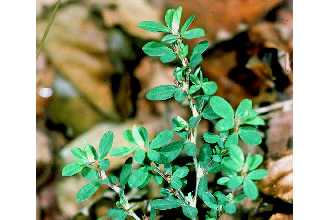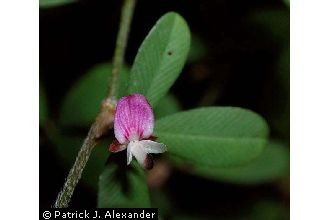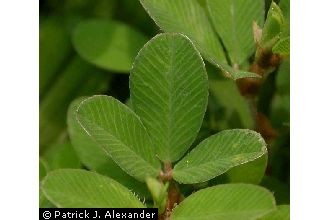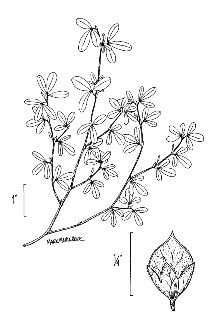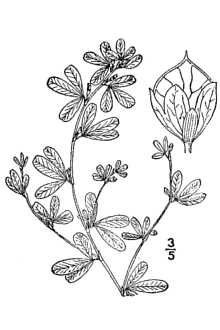Lespedeza striata (Thunb.) Hook. & Arn.
Scientific Name: Lespedeza striata (Thunb.) Hook. & Arn.

| General Information | |
|---|---|
| Usda Symbol | LEST4 |
| Group | Dicot |
| Life Cycle | Annual |
| Growth Habits | Forb/herb |
| Native Locations | LEST4 |
Plant Guide
Use a soil moisture meter to monitor the soil moisture where Lespedeza striata (Thunb.) Hook. & Arn. is planted.
Fact Sheet
Alternate Names
Lespedeza striata (Thunb.) Hook. & Arn.
Uses
Annual lespedezas are generally used for wildlife food and cover, forage, cover or nurse crop, and as temporary cover for erosion control.
Status
Please consult the PLANTS Web site and your State Department of Natural Resources for this plant’s current status (e.g. threatened or endangered species, state noxious status, and wetland indicator values).
Weediness
This plant may become weedy or invasive in some regions or habitats and may displace desirable vegetation if not properly managed. Please consult with your local NRCS Field Office, Cooperative Extension Service office, or state natural resource or agriculture department regarding its status and use. Weed information is also available from the PLANTS Web site at plants.usda.gov.
Description
Common and Korean lespedezas (Kummerowia stipulacea) are introduced, annual, warm-season legumes. Flowers and seeds are borne in the leaf axils at the tips of stems and branches in the Korean lespedeza and in the leaf axils all along the stem in common lespedeza. Two types of flowers are produced. One is readily seen as purple-bluish and the other has no petals and is inconspicuous. Korean lespedeza has a much broader leaflet and stipule than common, and growth is generally larger and coarser. Common lespedeza grows more prostrate. The seed varies from the shiny black of Korean to the stippled seed of common. There are approximately 343,000 seeds per pound of common lespedeza and 240,000 seeds per pound of Korean lespedeza.
Adaptation and Distribution
Distribution
Distribution
Korean is better adapted than common lespedeza in the North because of its shorter life cycle. Both types grow in a pH range of 4.5-7.0, but do best at 6.0-6.5. Common lespedeza (cultivar ‘Kobe’) is more tolerant of acid soils. They both grow in soil textures ranging from sands to clays and at fertility levels from low to high. Robert H. Mohlenbrock USDA NRCS 1991. Southern Wetland Flora @USDA NRCS PLANTS Common lespedeza is distributed throughout the east and southern Midwest. For a current distribution map, please consult the Plant Profile page for this species on the PLANTS Website.
Establishment
Seeding should be done in the early spring at a rate of 25 to 40 lb/acre in a well prepared seedbed, Seeding may be accomplished by drilling or broadcasting, If drilling, the seed should be placed at a depth of ½ inch, When broadcasting the seed, incorporate lightly by raking and then pack the soil surface, As with all legumes, the correct species rhizobial bacteria innoculant should be used, Annual Lespedeza may be seeded alone or preferably mixed with grain, grass, or other legumes, Soil fertility should be adjusted according to soil test recommendations, , Use soil moisture sensors to measure the soil moisture of Lespedeza striata (Thunb.) Hook. & Arn..
Management
Annual lespedezas should be grazed or cut for hay when in ½ bloom stage. All harvesting methods should leave a 3-inch stubble. Lespedezas are good companions with bunch-type grasses such as timothy, orchardgrass, and tall fescue. Sod-forming grasses such as Kentucky bluegrass provide too much competition. The advantage of using lespedeza with grasses is that the legume can provide much needed summer grazing when cool-season grasses are dramatically slower in biomass production. Lespedezas will reseed themselves but must be mechanically reseeded at some point to maintain adequate stands.
Pests and Potential Problems
Annual lespedezas are relatively unaffected by insect pests and diseases. Cultivars, Improved, and Selected Materials (and area of origin) ‘Kobe’ is the one important variety of common lespedeza. The three cultivars of Korean are ‘Climax’, ‘Harbin’, and ‘Rowan’. Seed is readily available from commercial seed dealers
Plant Traits
Growth Requirements
| Temperature, Minimum (°F) | 8 |
|---|---|
| Adapted to Coarse Textured Soils | Yes |
| Adapted to Fine Textured Soils | Yes |
| Adapted to Medium Textured Soils | Yes |
| Anaerobic Tolerance | Low |
| CaCO3 Tolerance | Low |
| Cold Stratification Required | No |
| Drought Tolerance | Medium |
| Fertility Requirement | Low |
| Fire Tolerance | Medium |
| Frost Free Days, Minimum | 160 |
| Hedge Tolerance | None |
| Moisture Use | Low |
| pH, Maximum | 7.3 |
| pH, Minimum | 4.9 |
| Precipitation, Maximum | 65 |
| Precipitation, Minimum | 30 |
| Root Depth, Minimum (inches) | 8 |
| Salinity Tolerance | Low |
| Shade Tolerance | Intolerant |
Morphology/Physiology
| After Harvest Regrowth Rate | Slow |
|---|---|
| Toxicity | None |
| Shape and Orientation | Decumbent |
| Nitrogen Fixation | Medium |
| Resprout Ability | No |
| Active Growth Period | Spring and Summer |
| Bloat | Low |
| C:N Ratio | Low |
| Coppice Potential | No |
| Fall Conspicuous | No |
| Fire Resistant | No |
| Flower Color | Purple |
| Flower Conspicuous | No |
| Foliage Color | Green |
| Foliage Porosity Summer | Porous |
| Foliage Texture | Fine |
| Fruit/Seed Color | Black |
| Fruit/Seed Conspicuous | No |
| Growth Form | Multiple Stem |
| Growth Rate | Rapid |
| Height, Mature (feet) | 1.3 |
| Known Allelopath | No |
| Leaf Retention | No |
| Low Growing Grass | No |
| Foliage Porosity Winter | Porous |
Reproduction
| Propagated by Seed | Yes |
|---|---|
| Propagated by Sod | No |
| Propagated by Sprigs | No |
| Propagated by Tubers | No |
| Fruit/Seed Persistence | No |
| Seed per Pound | 340240 |
| Seed Spread Rate | Rapid |
| Seedling Vigor | High |
| Small Grain | No |
| Vegetative Spread Rate | None |
| Propagated by Corm | No |
| Propagated by Container | No |
| Propagated by Bulb | No |
| Propagated by Bare Root | No |
| Fruit/Seed Period End | Summer |
| Fruit/Seed Period Begin | Spring |
| Fruit/Seed Abundance | High |
| Commercial Availability | Routinely Available |
| Bloom Period | Early Spring |
| Propagated by Cuttings | No |
Suitability/Use
| Veneer Product | No |
|---|---|
| Pulpwood Product | No |
| Protein Potential | Low |
| Post Product | No |
| Palatable Human | No |
| Palatable Graze Animal | High |
| Palatable Browse Animal | Low |
| Nursery Stock Product | No |
| Naval Store Product | No |
| Lumber Product | No |
| Fodder Product | Yes |
| Christmas Tree Product | No |
| Berry/Nut/Seed Product | No |

